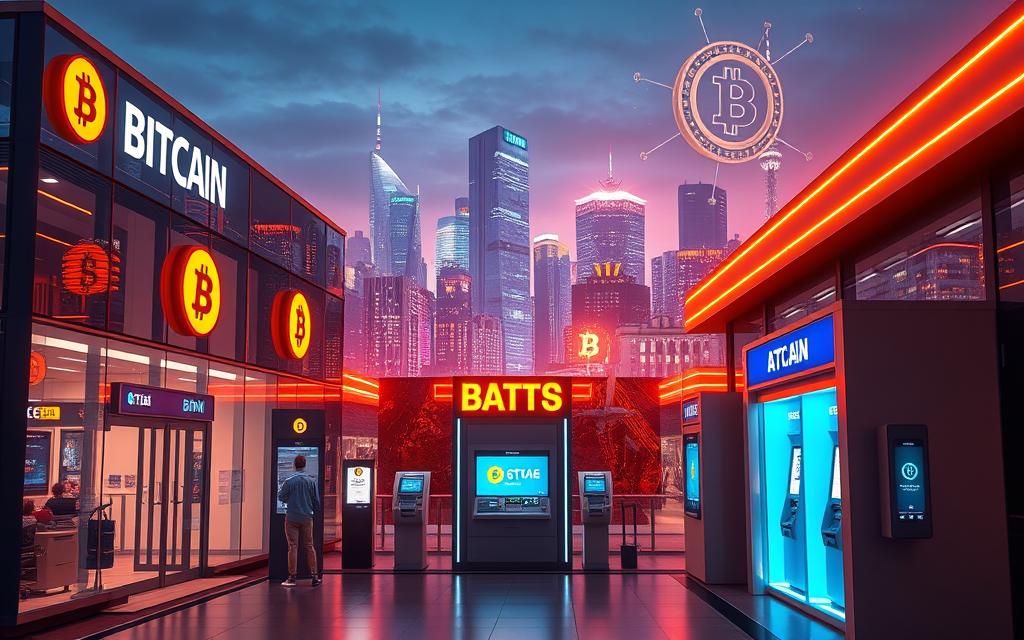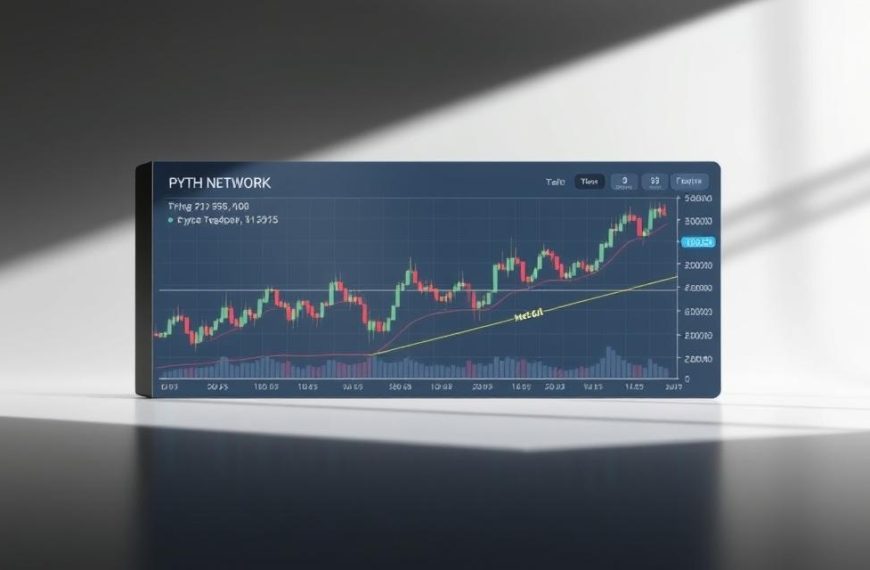Traditional finance and blockchain technology now meet through crypto-friendly banks. These banks are key for businesses and investors. They link digital assets to regulated banking, providing services like secure storage and easy money changes.
They play a big role, like how smartphones changed finance in the 2010s. This change makes finance more accessible to everyone.
Switzerland’s SEBA and Singapore’s DBS are leading the way. They offer blockchain accounts and strict rules. This lets clients trade, store, and grow digital assets safely. They are important for global cryptocurrency banking solutions.
In the US, these services solve big problems. They offer clear audit trails, real-time checks, and work with old financial systems. Banks like JPMorgan Chase and Customers Bank give tools once only for tech giants. This makes things fairer for smaller businesses.
By 2025, banks need to see digital assets as main business. They should offer products that make money and work with APIs. Modern digital asset banking focuses on being flexible and stable. This shows crypto’s important role in future finance.
What Makes a Bank Crypto-Friendly?
To find banks that link traditional finance with digital assets, we look at three key areas. These are technical setup, rules, and services for users. Modern crypto banks offer special services that meet market needs and follow new rules.
Defining Crypto Banking Compatibility
Real crypto banking is more than just opening an account. Banks need to have fiat-crypto conversion gateways and strict checks. This balance is seen in Mercury’s work with FDIC-insured partners. Banks must handle two main areas well.
Account types supporting fiat-crypto conversions
Top banks now have hybrid accounts that help with:
- Automated Clearing House (ACH) integration like Ally Bank’s instant settlement system
- Dedicated wallets for stablecoin transactions
- Multi-currency IBAN accounts with crypto off-ramp functionality
These options let users move between GBP, EUR, and digital assets easily. This is key for businesses dealing with international crypto payments.
Blockchain transaction monitoring capabilities
After 2023, MiCA compliance will require banks to check crypto transactions in real-time. Good banks use:
- Address screening against OFAC sanction lists
- Pattern recognition for mixers and tumblers
- Automated Suspicious Activity Report (SAR) triggers
Goldman Sachs’ use of Chainalysis Reactor shows this trend. It mixes blockchain monitoring with old anti-fraud methods. US banks are also getting ready for 2025 rules by creating their own analytics, like the EU.
Leading US Banks Embracing Cryptocurrency
Traditional banks are quickly moving into the world of cryptocurrency. They now offer special services for digital assets. This includes everything from safe storage for companies to rewards for regular customers. JPMorgan’s Onyx platform is a great example, allowing big deals on the blockchain while keeping accounts safe.
Bank of America: Institutional Crypto Services
America’s second-largest bank is helping big businesses use cryptocurrency. It has merchant payment solutions that let companies accept digital money. This makes it easy to deal with the ups and downs of digital currency.
For big clients, Bank of America offers:
- Secure cold storage solutions
- Real-time audit trails
- Regulatory compliance monitoring
Chase Bank: Retail Investor Support
JPMorgan Chase is helping everyday people with cryptocurrency-linked credit cards. Customers get 1.5% cashback in Bitcoin on all their purchases. This cashback is automatically put into Coinbase or Gemini accounts.
Partnerships with Coinbase and Gemini
These partnerships make it easy to move money between Chase accounts and big trading platforms. Users get:
- Instant USD-to-crypto conversions
- No withdrawal fees for first-time transfers
- Integrated portfolio tracking
Goldman Sachs: Prime Brokerage Innovations
The investment banking giant has a bitcoin futures trading platform for big clients. Its most exciting service is cryptocurrency-collateralised loans. This lets borrowers use their crypto to get traditional loans.
Fidelity Investments: Full-Spectrum Digital Asset Management
Fidelity is changing retirement planning with Bitcoin 401(k) plans. Employees can put up to 20% of their retirement savings into cryptocurrency. For institutions, it offers top-notch crypto custody solutions for almost all digital assets.
| Bank | Key Services | Unique Features |
|---|---|---|
| Bank of America | Corporate custody | Merchant payment APIs |
| Chase Bank | Crypto credit cards | Exchange partnerships |
| Goldman Sachs | Futures trading | Crypto-backed loans |
| Fidelity | Bitcoin 401(k)s | Multi-asset custody |
Regional and Digital-First Banking Alternatives
While big banks slowly add crypto services, smaller and digital-first banks are leading the way. They meet specific needs that big banks often miss. This includes special services for those who love cryptocurrencies.
Unlike big names like Revolut, which can’t trade crypto fully in the US, these banks focus on working well with blockchain. They make sure users can easily move money between different types of assets.
Ally Bank: Crypto Exchange Integrations
Ally Bank is known for working directly with major crypto exchanges. It lets users send money to places like Coinbase easily. This makes moving money between different types of assets smoother.
Automated clearing house (ACH) transfers to exchanges
Ally’s ACH system is fast, taking only 1-3 business days for crypto transactions. This is much quicker than usual wire transfers. It also skips the need for manual checks through its API.
Real-time transaction monitoring systems
The bank uses AI to watch for any odd crypto transactions. It sends SMS alerts right away for big withdrawals. This keeps things safe while being easy to use.
Quontic Bank: Bitcoin Mortgage Solutions
Quontic Bank is changing how we buy homes with its Bitcoin-denominated mortgage products. It lets people use their crypto as collateral. This is great when the crypto market is up and down.
Crypto-denominated mortgage products
The bank uses the 30-day average Bitcoin price to figure out loan-to-value ratios. This helps avoid problems from quick price changes. The interest rates start at 6.5% for crypto-backed loans.
Blockchain-based property deeds
Quontic keeps deed records on a private Ethereum blockchain. This means ownership can be checked instantly. It makes finding out who owns a property much faster and stops fake claims.
These smaller banks show how digital-first banking can keep up with crypto trends better than big banks. They offer special services like asset-backed loans and blockchain record-keeping. These are areas where big banks are behind.
Essential Features of Crypto-Compatible Accounts
Modern crypto-friendly banking solutions have advanced tech. They make managing digital assets easier. Features like multi-network support and automated compliance tools meet both efficiency and regulatory needs. Let’s look at the key features of next-generation crypto accounts.
Multi-Chain Wallet Support
Top banks now offer wallets that work with multiple blockchain networks. This means users can handle different assets like Bitcoin, Ethereum, and Solana in one place. It cuts down the need for many accounts on different exchanges.
ERC-20 vs BEP-20 Compatibility
Wirex is a great example, supporting over 150 tokens on Ethereum (ERC-20) and Binance Smart Chain (BEP-20). This makes it easy for DeFi and NFT trading without having to switch networks.
Advanced accounts have built-in cross-chain swaps. This lets users swap assets between different blockchains directly. For example, Mercury lets users exchange Bitcoin for Polygon’s MATIC without extra steps. The benefits include:
- No third-party exchange fees
- Instant settlements across networks
- Better access to liquidity
Tax Reporting Integration
Strong tax reporting tools are essential for crypto accounts. This is because of changing rules from HMRC in the UK and the IRS in the US. These tools handle complex tasks and keep records ready for audits.
Autonomous Capital Gains Calculations
Coinbase’s tax portal shows how it works. It sorts transactions into income, gifts, or trades. It uses HIFO accounting to lower tax bills, which is great for traders.
HMRC-Compliant Documentation
CoinLedger makes reports that meet HMRC’s Cryptoassets Manual. These reports include:
- Detailed capital gains summaries
- Tax on staking rewards
- Opportunities to reduce losses
This automation cuts down errors by 78%, as shown in fintech audits. It also keeps data safe with enterprise-grade security.
Risk Management Considerations
Dealing with cryptocurrency banking needs strong protection against market changes and legal issues. Banks use advanced tools to protect customers and follow new rules.
Volatility Protection Mechanisms
Banks use smart systems to fight against crypto price changes. These tools help investors stay safe during market ups and downs.
Automatic fiat conversion thresholds
Goldman Sachs and others let users set levels for switching to traditional currency. If crypto prices fall, the system sells it and keeps the money safe.
Price-stable crypto savings accounts
Some banks offer accounts that keep your money stable while earning interest. These accounts mix the chance for crypto growth with the safety of traditional savings.
Regulatory Compliance Factors
A new US law in 2025 will make digital asset rules stricter. Banks must use better checks to avoid fines.
Travel rule implementation standards
SEBA Bank and others use blockchain tools to track transactions. This helps meet global rules for sharing data on big transfers.
OFAC sanction screening protocols
Wallets check addresses against government lists in real-time to stop banned transactions. Top platforms update their lists every hour to keep up with new rules.
Critical note: FDIC insurance covers up to $250,000 for traditional deposits, but not for crypto. Despite updates in 2023, crypto investors are at risk from exchange failures or hacking.
The Evolving Landscape of Digital Asset Banking
Banking is changing fast with cryptocurrencies and blockchain. Central bank digital currencies (CBDCs) and DeFi integration are key topics now. They are shaping the future of finance.
Central Bank Digital Currency (CBDC) Developments
The US Federal Reserve is working on a digital dollar. They’re testing systems that can handle 1.7 million transactions per second. This is to balance privacy and prevent fraud, sparking debates on government control in digital finance.
Federal Reserve’s Digital Dollar Prototypes
Phase three trials include features for conditional payments. For example, tax rebates for education. This raises important questions:
- How much control should monetary authorities wield?
- Can digital currencies coexist with physical cash?
- What cybersecurity safeguards prevent systemic risks?
While federal plans face challenges, states like Texas and Wyoming are moving forward. Texas’s LoneStar Coin allows for quick energy trade settlements. It shows how local solutions can address national gaps.
“State-issued stablecoins could become laboratories for monetary innovation, provided they meet strict reserve requirements.”
Decentralised Finance (DeFi) Integration
Traditional banks are connecting to DeFi through three main ways:
- Tokenised asset custody solutions
- Cross-chain interoperability protocols
- Regulatory-compliant yield products
Bank-Mediated Liquidity Pool Access
Banks like Bank Frick offer clients access to decentralised exchanges. They use managed vaults. This mix of DeFi’s 24/7 markets and traditional risk controls is key for wider adoption.
| Feature | CBDC Solutions | DeFi Integration |
|---|---|---|
| Transaction Speed | 1-3 seconds | 15-60 seconds |
| Regulatory Oversight | Centralised | Hybrid Models |
| Interest Rates | Fed-Determined | Algorithmic |
Smart Contract Auditing Services
Big audit firms are teaming up with blockchain experts. KPMG’s Chainproof service is a good example. It combines penetration testing with financial risk analysis for DAOs.
SolarisBank’s API-driven approach shows how old banks can join DeFi. Their system checks liquidity pools against OFAC sanctions. This is a key step in today’s regulatory world.
Conclusion
Crypto-friendly institutions like JPMorgan, Revolut, and Fidelity Investments are changing the financial world. They show how old banking meets new blockchain tech. Now, you can get everything from Bitcoin mortgages to top-notch custody services.
When picking a bank, look at their security, rules, and support for digital assets. This is key.
Market trends show 78% of big financial firms want to offer more tokenised assets by 2025. This shows they trust in crypto more. Banks like Goldman Sachs are now helping crypto funds, and Revolut makes it easy for everyone to use staking and multi-chain wallets.
This shows how important it is to choose banks that fit your needs now and in the future.
Regulations are also getting better, with banks like Bank of America watching transactions in real-time. For big deals, talking to experts in digital asset management is a good idea. Many banks have special crypto teams to help with tricky stuff.
The future will bring more mixing of old finance and new tech, like CBDC trials and DeFi hybrids. Smart investors look for banks that have clear plans for these changes and keep things safe. As the field grows, picking banks that can adapt and be open is key to making the most of digital finance.


















